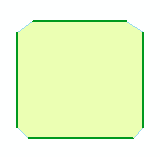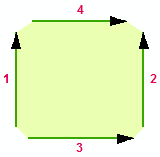Polygons from Polylines
Purpose
This tool allows converting polylines into one or multiple polygons. The resulting polygons can be saved in a new shapefile or as a geodatabase feature class.
|
Input polyline layer |
Output polygon |
||
| Simple polygon building algorithm |
|
→ |
|
| Advanced polygon building algorithm |
|
→ |
|
Description
If no polylines are currently selected, all polylines in the layer will be processed. The input polylines can be single-part, multi-part or mixed in the layer.
If polylines from more than one layer will be used to build the polygon, the necessary polylines need to be assembled in a separate layer before running the tool.
In case of using simple algorithm for creating polygons there is no need to snap the polylines together, as the gaps between the polylines will be bridged with the straight lines. The tool checks the input layer for intersections and marks the intersection points with the red points (graphic objects).
The output attribute table will not contain the input polyline layer attributes.
Usage
The following parameters can be specified in the tool dialog:
-
Order by field - allows specifying the order in which the input polylines will be connected while creating the polygon (polygons). This option can be used if the input features ordering is known and is required to be considered. In this case the digitizing order of polylines is also considered, that is, the polygon will be built from the end point of the first polyline till the start point of the next polyline. By default, no field is selected. In this case no order is considered.
The order can be specified by any appropriate attribute field. To specify the order for polylines, the fields of different types can be used: numeric, text, date etc.
This option is not available for the advanced polygon building algorithm.
|
Input polylines ordered: |
Polygon built without considering the input features order: |
Polygon built considering the input features order: |
|
|
|
|
-
Group by field - allows creating multiple polygons specifying a grouping field by which the input features will be grouped. The fields of different types can be used for grouping: numeric, text, date etc. If this option is used, the output polygon layer will contain the grouping field with the values.
| Input polyline layer with data for grouping in the attribute table: | ||||||||||||||||||||||||||||||||||
|
|
|
|||||||||||||||||||||||||||||||||
| Output layer with polygons built using the grouping polylines option: | ||||||||||||||||||||||||||||||||||
|
|
|
|||||||||||||||||||||||||||||||||
-
Polygon building algorithm – allows selecting the polygons creation method, either simple or advanced.
Simple algorithm – for this method of creating polygons the order of input polylines, sorting, and topological accuracy of the input data are very important to get the expected result. The tool does not break the polylines at the crossing points, that is, you will need to manually remove intersections and dangling nodes related to these intersections and only after that to run the tool using the simple algorithm option on the newly prepared polyline layer.
|
Input polyline layer: |
Polygons built using simple algorithm: |
|
|
|
Advanced algorithm – this method does not require specifying the field for ordering and does not consider the digitizing order or the input polylines sorting. Unlike the simple algorithm, the advanced algorithm allows building more accurate polygons and does not require checking the topological accuracy of the input data.
|
Input polyline layer: |
Polygons built using advanced algorithm: |
|
|
|
-
Tolerance – allows specifying the distance between lines that are not connected with each other, within which the points coordinates are considered identical. Specifying the tolerance, you can decrease number of “dangling” polylines and so get more output polygons without preliminary topological correction of the input data.
|
Input data: |
No tolerance specified: |
Tolerance of 100 m: |
Tolerance of 250 m: |
 |
|
|
|
|
|
|
100m |
-
Label points – allows using the point feature class as the labels source for the output polygons. The text field specified in the Display Expression on the Display tab of the point layer properties is used as label values. As a result, the text values from the specified point layer will be saved in the attribute table of the output polygons.
|
Input data: |
Output polygon layer: |
||||||||||||||||||||||||||||||||||||
|
|
|
||||||||||||||||||||||||||||||||||||
|
Point layer contains field for labels: |
Polygons contain label values from point layer in the Label field: |
||||||||||||||||||||||||||||||||||||
|
|



























